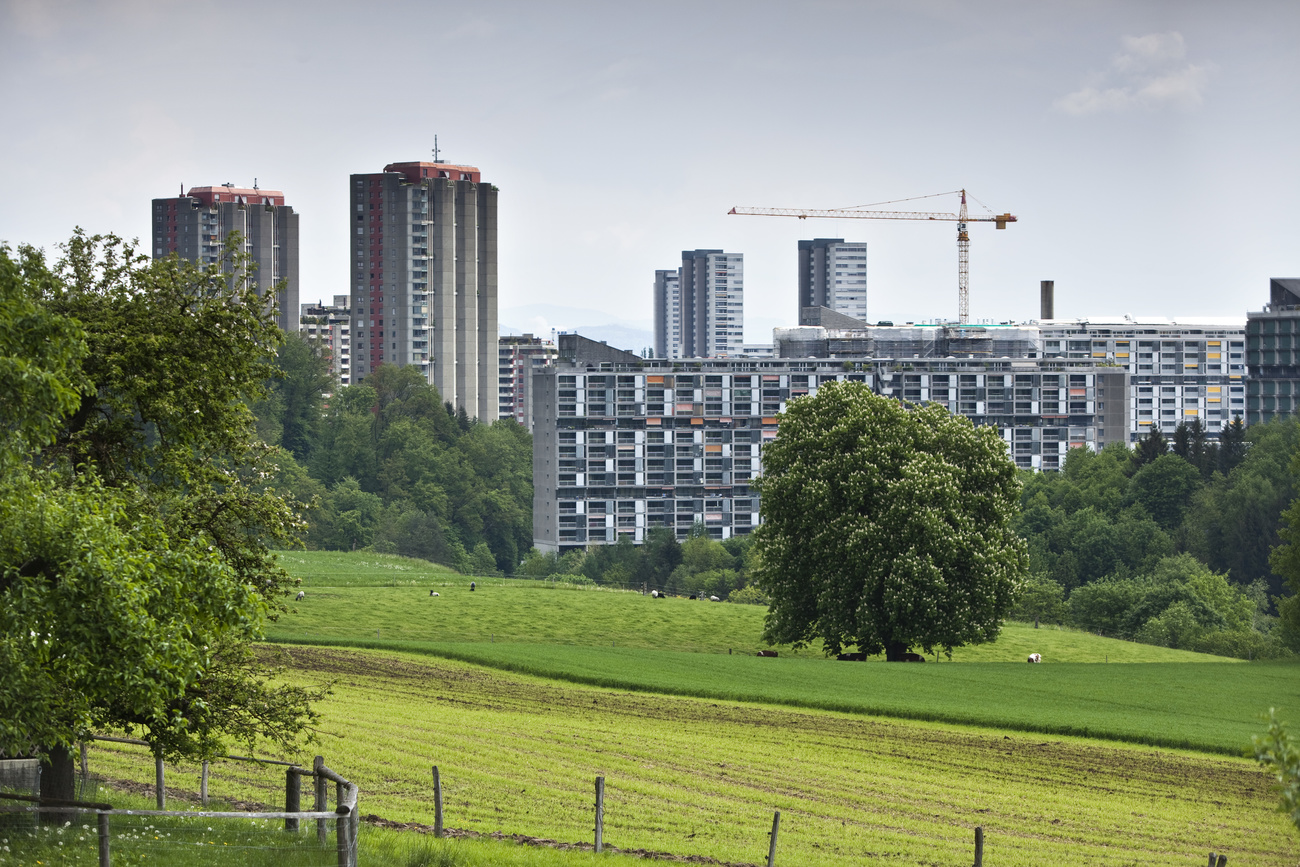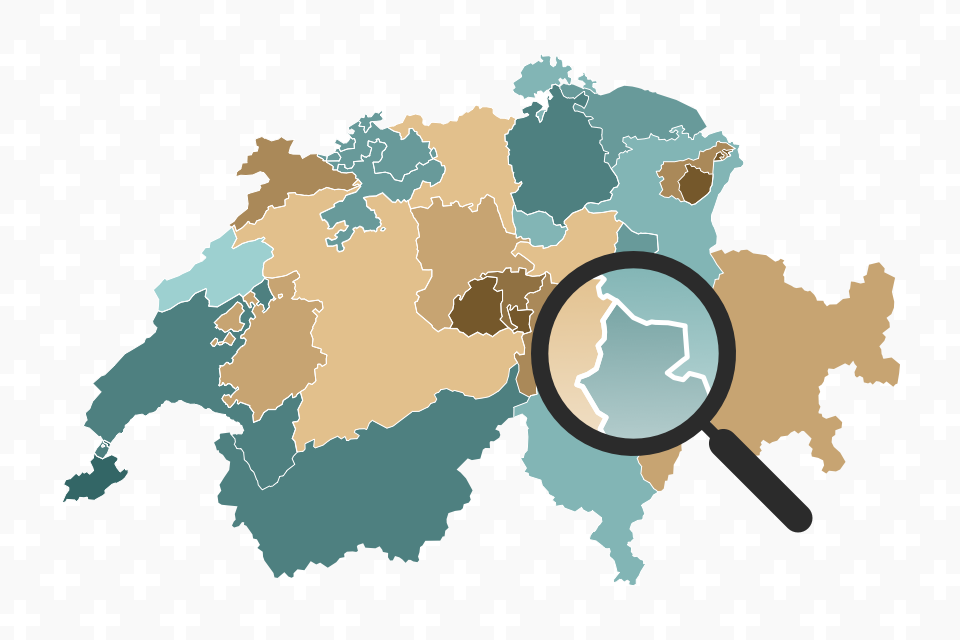
Why the rural-urban rift is less deep in Switzerland than elsewhere

City and country dwellers often vote differently. Yet in Switzerland, statistics indicate that the gap is less pronounced than in other countries.
In recent years, political analysts have often opposed conservative, inward-looking country folk with a more progressive and cosmopolitan urban crowd. The divide has come up during the Brexit vote in the United Kingdom, the election of Donald Trump in the United States and the yellow vests movement in France.
In Switzerland, the June 13 vote sparked a renewed debate on the rural-urban divide. Major cities were isolated in supporting the three environmental issues put to the ballot. The more rural population voted against. But how relevant is the debate in a country where the border between city and countryside is so blurred?

More
Vote results: March 7, 2021
The city is ‘colonizing’ the countryside
Although much of Switzerland is rural, the countryside is highly urbanized. The vast majority of the population is concentrated in cities and conurbations, making it one of the most urban countries in the OECD.
“We have long been witnessing a ‘colonization’ of the countryside by the city, which makes it difficult to contrast these two areas,” says Vincent Kaufmann, professor of urban sociology at the Swiss Federal Institute of Technology in Lausanne (EPFL) and scientific director of the Mobile Lives Forum.
Many of those who live in rural or intermediate areas commute to work in the cities, but have settled in the countryside for a better quality of life, the specialist explains. According to national statistics, nearly 9 out of 10 jobs are found in urban areas. The nature of employment is also changing in rural regions, where “proportionally speaking, the farming community is now marginal,” he adds.
The Swiss countryside is not a desert
Compared with other European countries, Switzerland has a high level of commuter mobility, thanks to its small size and good rail infrastructure. As Kaufmann argues, this helps limit the geographic divide, in a way that would be almost impossible in much of rural France, for instance.
Several million French live in “hyper rural” areas, especially in the centre of the country. These regions are far from the major cities, poorly served by public transport and often lack a proper telecommunications network. Some 10% of the population, mainly rural, lives more than 30 minutes from an emergency medical service, according to a recent study.
In England, too, rural populations live on average 26 minutes by car, and more than one hour by public transport, from the nearest hospital.
In Switzerland, meanwhile, access to public infrastructure is generally less of a problem. Health services are certainly under-represented outside the city centers, with fewer than one in three rural municipalities having a doctor’s practice. But the public transport network is extensive and a large town often close by. Even rural residents are, on average, 9 kilometres from the nearest hospital ( against 3 kilometres in the city, see graph).
The International Social Security Association (ISSA), which has analysed the issue of ‘medical deserts’ in several countries, concluded that the situation in Switzerland was “not worrying” and that any gaps could be overcome thanks to the short distances involved.
In Kaufmann’s view, the decentralized political system in Switzerland, as in Germany, also “helps reduce the rift between different types of area.”
There is, moreover, no “digital divide” in Switzerland. The proportion of rural households with broadband internet access is one of the highest in the OECD (94%, compared to just over 40% in the EU) and the basic digital skills of the rural population are among the highest in Europe, according to Eurostat.
Thanks to the level of infrastructure, remote-working is possible almost everywhere. If more city dwellers moved to rural areas as a result, “the nature of city-country relations could change even further,” Kaufmann asserts.
Housing and cars are divisive issues
There are, nonetheless, lifestyle differences between rural and urban residents, which can determine how they vote. The political scientist and historian Claude Longchamp pinpoints two key factors. The first is home-ownership. The proportion of home-owners is far higher in the countryside than in cities (e.g. over 70% in the mountain district of Rarogne in Valais canton, as against 37% on average in Switzerland as a whole and a mere 9% in Zurich).
The second difference concerns the use of private cars for daily travel. City dwellers are far more likely to use non-motorized or public transport than the rural population. Thus, car density is significantly higher than the national average in the rural cantons of Schwyz and Valais, and lowest of all in Geneva and Basel.
The urban sociologist Kaufmann is convinced that this is a decisive factor when it comes to voting, as it means “people don’t relate to their surroundings in the same way.” In Longchamp’s view, this gives rise to “very significant divergences of interest,” which clearly comes to light when people vote on issues to do with housing and roads, as well as farming life.
Such was the case with the June 13 vote. The city-countryside gap was unusually wide on the three environmental issues (CO2 law and anti-pesticide initiatives). The German-language news site Republik underscored the strong correlation between home-ownership rates, the density of private cars and the vote against the CO2 law.
Since 2018, only one other initiative, calling for more public support for low-cost housing (an urban issue), has resulted in a comparable rift.
The inhabitants of conurbations, meanwhile, are ambivalent and may lean one way or the other, depending on the issue at hand. On economic matters, according to Longchamp, they tend to vote like the urban centres where they work, while on questions affecting their lifestyle they side with their rural neighbours. On June 13, the conurbations joined forces with the countryside, with which they shared common interests, leaving the main cities isolated.
According to Kaufmann, this also means that a far from negligible proportion of urban citizens were receptive to the farmers’ arguments, showing that the gap is not as wide as one might have thought.
‘Everywheres’ and ‘somewheres’
Beyond these specific divergences of interest, the city-countryside divide can be linked to two diametrically opposed worldviews, one global and the other local.
After the Brexit vote, which won broad support in rural areas and was rejected in the cities, the idea, developed by a British journalist, of a gulf between people defined as “somewheres”, who are generally less qualified and penalized by globalization, and those defined as “everywheres”, who are mobile and cosmopolitan, gained traction around the globe. This rift between localism and cosmopolitanism was highlighted during the election of Donald Trump in 2016, and again at the end of 2018, in explaining the anger of the yellow vests in France.
In the view of the expert on urban issues, Kaufmann, globalisation has brought about one of the most significant transformations of Switzerland in the past 30 years. “Some parts of the country operate in a global network, while others have remained very local, and that’s a challenge,” he says.
According to the political scientist Longchamp, Swiss urban centres tend to vote in a more “global” way than the countryside on certain topics, in particular regarding foreign policy. This is possibly what happened when the “Responsible Business Initiative” was rejected in November, despite strong backing from the cities.
Other deeper rifts
The issue of a rural-urban, or local-global, divide is not a new one. It was already manifest in the 1992 vote on membership of the European Economic Area. According to Longchamp, there is no clear evidence to suggest that the gap has widened in recent years.
“In Switzerland, it affects one vote in 10,” he continues. Other sociological divides are at work (linguistic region, age, sex, etc.), but “the deepest one remains the political divide, between left wing and right wing, between progressive and traditional parties.”
This said, he adds, the 2015 national elections were the first to show a rural-urban split for three political parties: the Social Democratic Party and the Green Party, which achieved the best results in the cities, and the Swiss People’s Party (conservative right), which prevailed in the countryside.
Longchamp is, in any case, categorical: the city-countryside divide is much less pronounced in Switzerland than in other countries – particularly those with a first-past-the-post and two-party electoral system, like the United States.

In compliance with the JTI standards
More: SWI swissinfo.ch certified by the Journalism Trust Initiative
































Join the conversation!